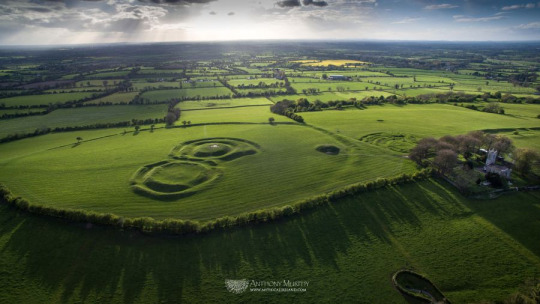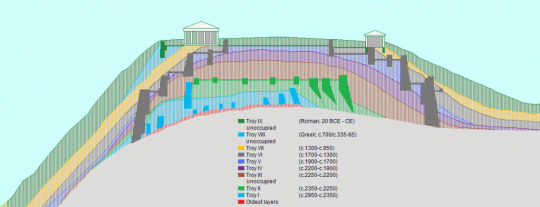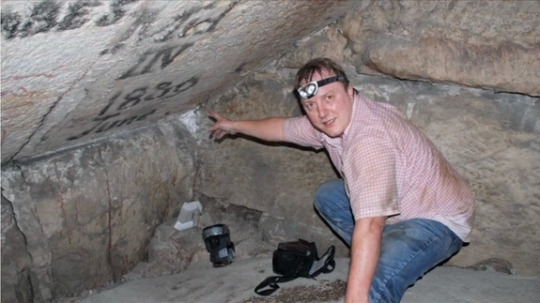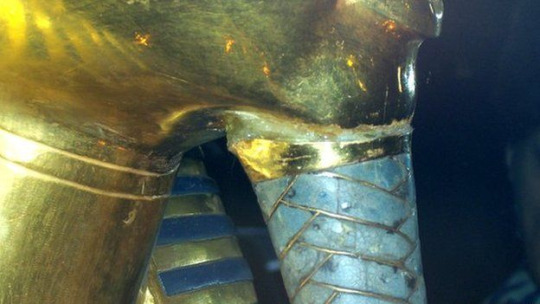#or pseudohistoricals as the case may be
Text
Top 5 Archaeological Sites and Relics that were Irreplaceably Damaged on Account of Human Stupidity
As a major in the humanities, nothing makes me more livid than learning about the loss or irreversible damage of an immensely important example of cultural heritage due to mankind’s massive propensity to royally screw something up. Reasons for such poorly thought-out actions that lead to the impairment of historical artifacts can be the result of either amateur archaeologists who foolishly believed they knew what they were doing to outright malicious acts of vandalism. Whatever the reason the outcome is still painfully the same: the erasure of a cultural site that is incrementally tied to the fabric of ones cultural identity, preventing those who share that same identity from engaging in their own heritage. Here are some examples I found the most serious.
5. A Bunch of Brits Damaged an Important Irish Archaeological Site Because they Believed they were the Descendants of Biblical Hebrews

Ah, the late 1800s. A time when the European industrial powers had begun to implement foreign policies with an overwhelming focus on dominating other countries, especially those in Africa and Asia, as a means of obtaining inexpensive raw materials to feed their growing economies. In terms of amount of land annexed and political dominance, there was no imperialist power more successful in this complex process than Great Britain. In order to justify such vastly one-sided geopolitical influence, social Darwinian theories were frequently espoused by British statesmen which had the habit of arguing that the supposedly “superior” white race had the right and the duty to civilize nonwhite races that were deemed inferior. However, some Englishmen wanted to take it a step further by advocating an even more ridiculous belief, known as British Israelism.
Influenced by writings, such as John Wilson’s 1840 Our Israelitish Origin, adherents of this theory suggest that the modern day inhabitants of the British Isles are, both genetically and linguistically, the direct descendants of the Ten Lost Tribes of ancient Israel. Apparently, according to the pseudo-etymology used by British Israelists, the Saxons are the descendants of the ancient Scythians, a nomadic people who resided on the Pontic Steppe. The Scythians are, in turn, the descendants of the biblical “Isaac,” due to the phonetic similarity between what the Persians called the Scythians, the Sacae, and Israel’s patriarch. The name, Saxons, is also further interpreted to mean “Sac’s sons” or “son of Isaac.”
If all this sounds preposterous to you, that’s because it pretty much is. The languages of the British Isles, such as English, Welsh, and Gaelic, and Hebrew belong to two completely separate language families. The former is Indo-European, while the later is Afro-Asiatic. However, these hints that their theory was nothing more that pseudo-linguistic drivel didn’t stop British Israelists from damaging one of Ireland’s most important archaeological sites, the Hill of Tara.
Considered one of the most sacred locales in Ireland and an important symbol of Irish nationhood, the Hill of Tara had been used for three thousand and a half years as a pagan burial site and, during the early Middle Ages, it served as the seat of the High Kings of Ireland. Between 1899 and 1902, British Israelists led by judge Edward Wheeler Bird began to frantically dig up the site, mutilating much of it, in hopes of, get this, discovering the legendary Ark of the Covenant. Because if the Ark of the Covenant would be anywhere it would be in a place ancient Hebrews had no idea even existed. As one could imagine, Irish cultural nationalists, including professional archaeologists and journalists, were furious but ultimately couldn’t do a thing to stop them since the excavators paid off the local landlord and guarded the site with firearms as a means of keeping a group of protesters away from the dig site.
4. A German Amateur Archaeologist uses a very “Unconventional” Method to Excavate Troy

Archaeological fieldwork, especially excavations, are an incredibly meticulous process. The long, painstaking procedure of acquiring grant funds, organizing staff and equipment, mapping out the appropriate dig site, removing earth one layer at a time, and sifting through buckets of dirt looking for artifacts may take months if not years to fully accomplish. There’s a perfectly good reason for such scrupulousness since attempting to excavating a site without the proper know-how is extremely haphazard and can potentially damage the very thing you’re trying to uncover. A perfect case of this are the actions of one Heinrich Schliemann.
Born in 1822 to a relatively poor family in northern Germany, Schliemann had been obsessed ever since he was seven years of age with discovering and excavating the legendary city of Troy. After acquiring a sizeable fortune working as a businessman, Schliemann traveled to western Anatolia where Troy was vaguely believed to have existed. He was then pointed to a to nearby tell (an artificial mound formed by the accumulated debris of generations of people who once resided in a settlement), called Hisarlik, which, according to an Englishman named Frank Calvert who owned the land the mound was located on, as a possible location of Troy. In 1870, Schliemann then gathered a team of about one hundred local laborers and began digging at the site for about three years until he made an astounding discovery: Hisarlik wasn’t just the site of a single, important city, but multiple ones layered on top of one another formed after millennia as the settlement had been repeatedly destroyed and rebuilt by inhabitants.
In order to reach the lowest layer, which he believed was Troy from the Iliad, Schliemann relied on a very unorthodox method that other archaeologists wouldn’t even consider using and for good reason: dynamite. Ancient cities and priceless artifacts were literally obliterated into dust due to his recklessness and poor record keeping until eventually Schliemann thought he found what he was looking for. When he finally reach one of the lowest layers, he discovered a cache of golden objects and jewels, which he proclaimed to be the treasure of Priam, the king of Troy in Homer’s poem. However, there was a serious problem. Not only did Schliemann destroy countless finds on his destructive mission to reach what he believed to be Troy, but the treasures he recovered were actually from a city that existed centuries prior. According to dating methods, the Troy from the Illiad was actually located in the strata Schliemann annihilated with dynamite.
3. The Great Pyramid of Giza is Vandalized by Two German Amateur Archaeologists because they Believed they were Built by Aliens

Currently, one of the primary disseminators of pseudoarchaeological and pseudohistorical theories is undoubtedly the New Age movement. Beginning in the 1960s, this philosophy, which suggests that the world has become too materialistic and has turned away from the spiritualism that is the heart of creation and that there is a non-physical reality than underlies our physical world, is largely responsible for much of the spread of evidence-less beliefs that are related to history and archaeology. These assertions include claims regarding lost, technologically advanced civilizations, such as Atlantis, Lemuria, or Mu, or the theory that aliens have visited us in the Earth’s past and influenced our culture. Such fantastical notions have largely exited the fringe and have become more accepted since the late 20th century thanks in part to being picked up and discussed the History Channel.
Generally speaking, these theorists are typically harmless when it comes to their presence at archaeological sites, that changed in 2013 when a couple of German amateur archaeologists decided to vandalized Egypt’s Great Pyramid of Giza in order to prove that the monuments weren’t built by ancient Egyptians. In April of that year, Dominique Goerlitz and Stefan Erdmann, as well as a filmmaker, were, for some reason, given permission to enter the inner chambers of the pyramid that’s normally closed off to the public and proceeded to take a number of samples from a cartouche, which is a hieroglyphic inscription that normally represents the name and title of an Egyptian monarch, and smuggle them out of the country to Dresden University for further study. Neither men were professional archaeologists, nor were the associated with any institute involved in the field.
Apparently, the purpose of their defacement was to prove their “alternate theory” that the pyramids weren’t built by ancient Egyptians. Rather, they proposed that the Egyptian pyramids were build by a technologically advanced civilization that had existed much earlier than around 2500 BCE, which is when the Great Pyramid of Giza is believed to have been built.
As you can imagine, both German and Egyptian government authorities were absolutely furious over their actions. The three German hobbyists, as well six Egyptian guards and inspectors who let them into pyramid in the first place, are now facing serious charges. Lastly both Goerlitz and Erdmann tried to apologize for their vandalism in a letter directed to Egypt’s Ministry of Antiquities but it has been rightfully rejected.
2. Museum Workers use Epoxy Glue to Repair Tutankhamun’s Mask

Without a doubt, archaeological restoration and conservation is a delicate and arduous task that demands a considerable amount of research. Besides it requiring a professionally trained team of conservators and restorers who’re capable of making sure the object matches its original condition as close as possible while using a variety of methods, it is also highly dependent on that team to be aware of the materials used when the object was constructed. Completing such work can take what seems like ages as the restorers meticulously reverse or preserve the appearance of famous works of art, while following a strict code of ethics and scientific guidelines. Interestingly, employees at the Egyptian Museum in Cairo decided to ignore all that nettlesome repair work when they accidently damaged one of Egypt’s most important works of art.
Back in 2014, the famous Mask of Tutankhamen was clumsily damaged when it had it’s beard broken off while employees were busy fixing a light in it’s display case. Instead of following protocol by relying professional restoration methods and acquiring an expert in art restoration, they made the astonishingly poor decision of hastily gluing the beard back on with a quick-dry epoxy, that is normally used for wood or metal, in order to conceal their crime. This was followed a reckless scrapping by using a spatula in order to get some of the excess glue off, which ended up causing a scratch. They then placed the mask back into the display case with the hopes that no one will noticed. Unsurprisingly, however, guests did notice in 2015 when, on closer inspection, the beard appeared off center and that there was clearly a visible layer of glue between the face and the beard.
Despite fears that the damage was completely irreversible, German restoration specialist, Christian Eckmann, along with a team of conservators, archaeologists, and natural scientists successfully removed the glue and reattached the beard in a delicate operation that took nine weeks. First, they took a 3d scan of the mask to document it and then they raised it’s temperature in order to safely remove the epoxy glue with wooden tools. They then proceeded to fasten the beard by recreating the same technique the ancients would have relied on using beeswax. Now, the mask has been put back on display since late 2015 after a lengthy procedure. Meanwhile, eight of the employees who botched the repair job have been referred to trial by the Administrative Prosecution and are accused of negligence and unrefined restoration of the mask.
1. Greenpeace Damages the Nazca Lines due to a Publicity Stunt

Located in the arid Nazca Desert of Southern Peru, the Nazca Lines are an impressive series of large geoglyphs that span an area of about 19 sq mi. Created sometime between 500 BCE and 500 CE, these expansive markings that were etched in a pebble-covered, windless landscape, vary in design, but they the majority normally come in the form of straight lines that, when combined, are eight hundred miles long. They also appear to depict a myriad of plants, animals, and humanoid figures, such as a hummingbird, monkey, and a whale, that are usually composed of a single continuous line. Since they were first intensively studied in the 1940s, the reason for their existence has largely escaped modern scholars, though there have been numerous theories as to their purpose.
In the past few decades, the extremely fragile geoglyphs have come under threat due to changes in global weather patterns brought on by climate change. Disturbances caused by human actions is also a risk, since the ground is notoriously sensitive due to the fact that the ground is made up of nothing more than black rocks atop white sand. So far any damage the Nazca Lines have attained due to either environmental factors and human impact have been regarded as minimal. However, in December 2014, they sustained damage from an unlikely source which managed to infuriate the Peruvian government. As part of a publicity stunt, individuals affiliated with the environmental organization Greenpeace, of all people, entered an area near the geoglyphs that is strictly prohibited due to the fact that a single step can cause permanent damage. Then, as part of a message meant for a highly important, UN-sponsored meeting regarding global warming that was occurring in Lima at the time, they proceeded to lay down big yellow cloth letters near the hummingbird geoglyph that read: “Time for Change, The Future is Renewable.” After observing drone footage taken in the aftermath of the stunt, it was revealed through visual evidence that new lines were formed after the activists hiked to the site and what appears to be an outline of the letter “C.”
In response to such recklessness, Deputy Cultural Minister Luis Jaime Castillo has threatened legal action against the activists for what he rightly referred to as a “slap in the face at everything Peruvians consider sacred.” The Peruvian government was also seeking to prevent the participants from leaving the country and sought to identify the careless activists. Meanwhile, Greenpeace did its best to apologize for their actions in a statement they issued which states they plan to entirely co-operate with any investigation Peru has planned out. Unfortunately for Greenpeace, the apology did go over well with the people of Peru, which prompted Castillo to refer to it as a “joke,” since Greenpeace had initially refuse to identify the vandals or accept responsibility. After mounting pressure, however, Greenpeace decided to release the names of four of the activists involved by giving their names to prosecutors in the hopes that they will drop the charges against two journalists who were also at the event.
#archaeology#vandalism#culture#hill of tara#saxons#troy#Heinrich Schliemann#dynamite#hisarlik#pyramid#giza#ancient aliens#mask#tutankhamun#epoxy#egypt#nazca lines#peru#greenpeace#ireland#turkey
4 notes
·
View notes
Text
Milk Names
Going to add this to my Chinese name guide when I’m satisfied with it.

In modern times, babies get named right away, if for no other reason that the government requires it everywhere in the world for record keeping purposes.
However, in traditional times, Chinese people did not give babies a permanent name right away, instead waiting until a certain period of time had passed (3 months/100 days is a classic).
What do you call the baby in the meantime? A milk name 乳名, which your (close, older than you) family may or may not keep on using for you until such time as you die, just so that you remember that you used to be a funny looking little raisin that peed on people.
This kind of name is almost always very humble, sometimes to the point of being outright insulting. This is because to use any name on your baby that implies you might actually like the little thing is tempting Bad News. Possible exception: sometimes a baby would receive a milk name that dedicated it to some deity. In this case, I guess you’re hoping that deity will be flattered enough to take on the job of shooing away all the other spirits and things that might be otherwise attracted to this Delicious Fresh Baby.
Because milk names were only used by one’s (older) family and very close family friends of one’s parents/grandparents, most people’s milk names are not recorded or known, with some notable exceptions. Liu Shan, the son of Liu Bei, who as a baby was rescued by Zhao Yun during the Shu forces retreat from Changban. Perhaps because his big debut in history/legend was as a baby, he is well-known for his milk name A-Dou 阿斗, which means, essentially, Dipper.
If you’re writing a story, you really only need to worry about a milk name for your character if it’s a historical (or pseudohistorical) setting, and even then only if the character either makes an appearance as a small infant or you consciously decide to have them interact with characters who knew them well as a small child and choose to continue using the milk name. Not all parents, etc who could use the milk name with a youth or an adult actually did so.
In my own works so far I’ve only come up with milk names for three characters, Little Mouse/Xiaoshu 小鼠 for a girl, Tadpole/Kedou 蝌蚪 for a boy, and Shouty/A-Yao 阿吆 for a boy. In the first two cases the babies were both smol and quiet (as babies go). The last one neither small nor quiet, ahahaha.
Edit: Here are some more milk names I came up with off the cuff, feel free to use, no credit necessary. Rongzi 冗子 "Unwanted Child"; Xiaochou 小丑 "Little Ugly"; A-Xu 阿虛 "Empty"; Pangzhu 胖豬 "Fat Pig"; Shasha 傻傻 "Dummy".
Son of Edit: I forgot two characters! I also gave a baby the milk name 蔷蔷 Qiangqiang, which is a pretty enough name meaning “wild rose” (duplication to make it lighter), except the baby is a boy, so this is the typical idea that making a boy feminine makes him worth less, which, yikes, but also, historically accurate. Also Xiaohei 小黑 “Blackie” for a work that I will probably never publish because I don’t ever see myself finishing it. I might recycle it to use on another story.
#chinese names#onomastics#milk names#chinese#mandarin#clouds and rain universe#chinese history#chinese culture#because we're ancient china#and life is a nightmare!
240 notes
·
View notes
Text
Maya Collaspe is NOT the disappearance of the Maya as a whole. It describes a particular case of several powerful Maya city states such as Tikal, Calakmul, Palenque, and etc being abandoned. These were Southern Lowland cities, whereas the Northern Yucatan experienced relative prosperity afterward.
Stop plugging pseudohistorical nonense. The Maya were not an empire, but numerous city states unified by a common culture and language. They never left. They were always there. They may have stopped making momuments or writings like in their Classic Era BUT THEY DID NOT DISAPPEAR.
6 notes
·
View notes